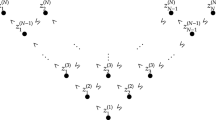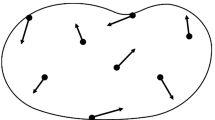Abstract
The purpose of this paper is to study the existence and uniqueness of solutions to a stochastic differential equation (SDE) coming from the eigenvalues of Wishart processes. The coordinates are non-negative, evolve as Cox–Ingersoll–Ross (CIR) processes and repulse each other according to a Coulombian like interaction force. We show the existence of strong and pathwise unique solutions to the system until the first multiple collision and give a necessary and sufficient condition on the parameters of the SDEs for this multiple collision not to occur in finite time.
Similar content being viewed by others
References
Anderson, G.W., Guionnet, A., Zeitouni, O.: An Introduction to Random Matrices, Cambridge Studies in Advanced Mathematics, vol. 118. Cambridge University Press, Cambridge (2010)
Bru, M.-F.: Diffusions of perturbed principal component analysis. J. Multivar. Anal. 29(1), 127–136 (1989)
Bru, Marie-France: Wishart processes. J. Theoret. Probab. 4(4), 725–751 (1991)
Chybiryakov O: Processus de Dunkl et relation de Lamperti, June (2006), Thèse Paris VI
Cox, J.C., Ingersoll, J.E., Ross, S.: A theory of the term structure of interest rates. Econometrica 53(2), 385–407 (1985)
Cèpa, E., Lépingle, D.: Diffusing particles with electrostatic repulsion. Probab. Theory Relat. Fields 107(4), 429–449 (1997)
Cèpa, E., Lépingle, D.: Brownian particles with electrostatic repulsion on the circle: Dyson’s model for unitary random matrices revisited. ESAIM Probab. Stat. 5, 203–224 (2001)
Cépa E: Équations différentielles stochastiques multivoques, Séminaire de Probabilités, XXIX, Lecture Notes in Math., vol. 1613, pp. 86–107. Springer, Berlin, (1995)
Demni, N.: The laguerre process and generalized Hartman-Watson law. Bernoulli 13(2), 556–580 (2007)
Demni, N.: Radial dunkl processes: existence, uniqueness and hitting time. C. R. Math. Acad. Sci. Paris 347(19–20), 1125–1128 (2009)
Dyson, F.J.: A Brownian-motion model for the eigenvalues of a random matrix. J. Math. Phys. 3, 1191–1198 (1962)
Forrester, P.J.: Log-gases and Random Matrices. London Mathematical Society Monographs Series, vol. 34. Princeton University Press, Princeton (2010)
Göing-Jaeschke, A., Yor, M.: A survey and some generalizations of bessel processes. Bernoulli 9(2), 313–349 (2003)
Graczyk, P., Malecki, J.: Multidimensional Yamada-Watanabe theorem and its applications to particle systems. J. Math. Phys. 54(2), 021503 (2013)
Graczyk, P., Malecki, J.: Strong solutions of non-colliding particle systems. Electron. J. Probab. 19(119), 21 (2014)
Graczyk, P., Malecki, J.: On squared bessel particle systems. Bernoulli 25(2), 828–847 (2019)
König, W., O’Connell, N.: Eigenvalues of the Laguerre process as non-colliding squared Bessel processes. Electron. Comm. Probab. 6, 107–114 (2001)
Karatzas, I., Shreve, S.E.: Brownian Motion and Stochastic Calculus. Graduate Texts in Mathematics, vol. 113, 2nd edn. Springer, New York (1991)
Katori, M., Tanemura, H.: Noncolliding processes, matrix-valued processes and determinantal processes [translation of mr2561146]. Sugaku Expos. 24(2), 263–289 (2011)
Katori, M., Tanemura, H.: Noncolliding squared Bessel processes. J. Stat. Phys. 142(3), 592–615 (2011)
Lamberton, D., Lapeyre, B.: Introduction to stochastic calculus applied to finance. Chapman & Hall/CRC Financial Mathematics Series, 2nd edn. Chapman & Hall/CRC, Boca Raton (2008)
Lépingle, D.: Boundary behavior of a constrained Brownian motion between reflecting-repellent walls. Probab. Math. Statist. 30(2), 273–287 (2010)
Rogers, L., Chris, G., Zhan, S.: Interacting Brownian particles and the Wigner law. Probab. Theory Relat. Fields 95(4), 555–570 (1993)
Rösler, M., Voit, M.: Markov processes related with Dunkl operators. Adv. Appl. Math. 21(4), 575–643 (1998)
Rogers, L.C.G., David, W.: Diffusions, Markov Processes, and Martingales. Cambridge Mathematical Library. Cambridge University Press, Cambridge (2000). Itô calculus, Reprint of the second (1994) edition
Revuz, D., Yor, M.: Continuous Martingales and Brownian Motion. Grundlehren der Mathematischen Wissenschaften [Fundamental Principles of Mathematical Sciences], 3rd edn. Springer, Berlin (1999)
Schapira, B.: The Heckman-Opdam Markov processes. Probab. Theory Relat. Fields 138(3–4), 495–519 (2007)
Trevisan, D.: Well-posedness of multidimensional diffusion processes with weakly differentiable coefficients. Electron. J. Probab. 21(22), 41 (2016)
Voit M, Woerner JHC.: Functional central limit theorems for multivariate bessel processes in the freezing regime, (2019), arXiv:1901.08390
Yor, M., Chybiryakov, O., Gallardo, L.: Dunkl processes and their radial parts relative to a root system. In: Graczyk, P., Rösler, M., Yor, M. (eds.) Harmonic and Stochastic Analysis of Dunkl Processes. Hermann, Paris (2008). Travaux en cours
Acknowledgements
We thank Djalil Chafai for numerous fruitful discussions. We also thank the referees for their remarks which helped us to improve the first version of the manuscript.
Author information
Authors and Affiliations
Corresponding author
Additional information
Publisher's Note
Springer Nature remains neutral with regard to jurisdictional claims in published maps and institutional affiliations.
Appendix
Appendix
The next lemma deals with the existence and uniqueness to the CIR SDE and with the probability for the solution to hit zero. It is proved, for instance, in [21, Theorem 6.2.2 and Proposition 6.2.3]. The point 4. comes directly from [5].
Lemma 6.1
Let \(a\ge 0,b,\sigma \in {\mathbb {R}}\). Suppose that W is a standard Brownian motion defined on \({\mathbb {R}}_+\). For any real number \(x\ge 0\), there is a unique continuous, adapted process X, taking values in \({\mathbb {R}}_+\), satisfying \(X_0=x\) and
Moreover, if we denote by \(X^x\) the solution to this SDE starting at x and by \(\tau _0^x=\inf \{t\ge 0 : X_t^x=0\}\),
-
1.
If \(a\ge \sigma ^2/2\), we have \({\mathbb {P}}(\tau ^x_0=\infty )=1\), for all \(x>0\).
-
2.
If \(0\le a <\sigma ^2/2\) and \(b\ge 0\), we have \({\mathbb {P}}(\tau ^x_0<\infty )=1\), for all \(x>0\).
-
3.
If \(0\le a <\sigma ^2/2\) and \(b<0\), we have \(0<{\mathbb {P}}(\tau ^x_0<\infty )<1\), for all \(x>0\).
-
4.
For all \(s>t\),
$$\begin{aligned}{\mathbb {E}}[r_s|r_t] = r_te^{-b(s-t)}+\frac{a}{b}(1-e^{-b(s-t)}). \end{aligned}$$
The following result is the Ikeda–Watanabe Theorem, which allows to compare two Itô processes if their starting points and their drift coefficients are comparable, and if their diffusion coefficients are regular enough. It is proved, for instance, in [25, Theorem V.43.1 p.269].
Theorem 6.2
(Ikeda–Watanabe) Suppose that, for \(i=1,2\),
and that there exist \(b:{\mathbb {R}}\mapsto {\mathbb {R}}\), such that
Suppose also that
-
1.
\(\sigma \) is measurable and there exists an increasing function \(\rho :{\mathbb {R}}_+\mapsto {\mathbb {R}}_+\) such that
$$\begin{aligned} \int _{0^+}\rho (u)^{-1}du=\infty , \end{aligned}$$and for all \(x,y\in {\mathbb {R}},\)
$$\begin{aligned} (\sigma (x)-\sigma (y))^2\le \rho (|x-y|); \end{aligned}$$ -
2.
\(X^1_0\ge X^2_0\) a.s.;
-
3.
b is Lipschitz.
Then, \(X^1_t\ge X^2_t\) for all t a.s.
Rights and permissions
About this article
Cite this article
Jourdain, B., Kahn, E. Strong Solutions to a Beta-Wishart Particle System. J Theor Probab 35, 1574–1613 (2022). https://doi.org/10.1007/s10959-021-01109-1
Received:
Revised:
Accepted:
Published:
Issue Date:
DOI: https://doi.org/10.1007/s10959-021-01109-1




